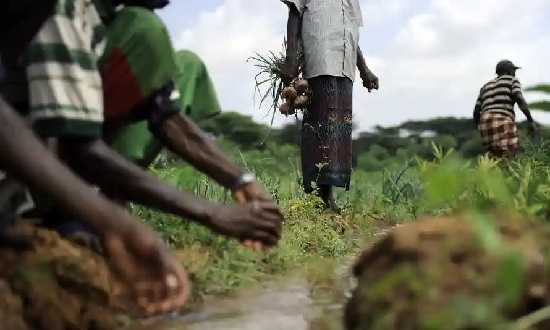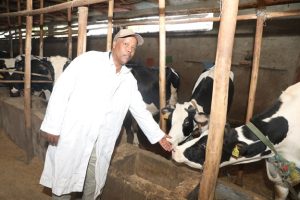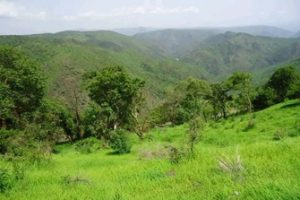
BY DARGIE KAHSAY
Due to a decrease in forest coverage and increase in land degradation, drought and desertification are expanding and widening across the globe. Due to recurrent droughts, agricultural developments are facing serious challenges mainly in developing countries due to the dependency on natural rainfall. According to experts in the sector, for sustainable agricultural development and to increase the productivity of the sector, it needs to manage desertification by developing adaptation and mitigation measures.
During a recent panel discussion entitled “Combating desertification and drought through restoration and recovery,” organized by Environment, Forest and Climate Change Commission (EFCCC) in the world desertification day, Dr. Adefris Worku, Green Legacy Technique Committee Team Leader said that desertification and drought are two of the major challenges facing humankind in climate sector.
Desertification and expansion of dry lands are expanding due to poor natural resource management practices like poor farming, overgrazing, degradation of soil fertility and structure, improper soil moisture, deforestation and climate change.
Desertification leads to a permanent decrease in the biological productivity of landscapes, Dr. Adefris said. To halt the expansion of desertification and to minimize its impact, Adefris added, it is a must to invest in reversing and recovering mechanisms by developing the adaptation and mitigation measures. The first way for mitigation and adaptation of climate is increasing forest coverage with new plantations and protecting the available forests from unnecessary damages.
In Ethiopia, dry land covers 75 percent and is expanding fast and change in land use is happening at a faster rate during the past 50 years, Dr. Adefris said citing studies. When a landscape becomes desertify, it affects the biological productivity of the area.
As to him desertification and drought have a linkage with poverty as it, directly and indirectly, affecting the productivity, livelihood of the people and health of the environment. Due to the expansion of drylands, desertification and land degradation, extreme drought events are becoming frequent and the droughts happening these days are severe.
As desertification increases, empty corners of land are growing. Citing Oxfam study, he stated that the cost of drought on Ethiopian annual GDP is beyond 1.1 billion USD and a 10 percent decrease in seasonal rainfall. On the long-term average, this translates into a 4.4 percent decrease in the food production of the country as it affects agriculture.
Annually, around 60 square kilometers of land is becoming desert across the world and according to desertification mapping of the world, Adefris stated, Africa, takes the lion’s share with Asia. For him, Africa’s desertification speed remains a serious concern and among the top problems of the continent.
Similarly in Ethiopia, he stated, desertification is expanding due to unmanageable expansion of agricultural activity, population growth and unwise forest management during the past years. In this regard, agricultural expansion and forest management are overlapping, which needs strong intervention.
According to him, in Ethiopia, out of the areas of moderate to high suitability or likelihood of being cultivated, 75 percent is in areas with some sort of forest coverage and 50 is in areas with a forest coverage greater than 50 percent. This, unmanageable expansion of agriculture in the forest areas is affecting the forest coverage and led to land degradation, this, in the long run, leads to desertification.
The very problem, according to Dr. Adefris is, Ethiopia and other developing countries are working to boost their agricultural productivity by cultivating additional land, not by intensive agriculture. Though there are developments in recent years, he added, unmanageable expansion of agricultural land was a serious problem in forest damaging, which plays its role in exposing the area to desertification. Even the prospects of the agricultural expansion in Ethiopia are looking to the forest areas unless it controls with strict laws, he stated.
As desertification is expanding and rapid climate change, Ethiopia’s drought vulnerability is increasing from time to time and not only increasing the droughts are very severe and worst. So, due to the increase of desertification and rapid climate change at the global, continental and national levels, the intensity and severity of drought are increasing. Due to this, land degradation, forest degradation, water degradation, soil degradation and poverty remains top problems.
According to an Oxfam survey, annually Ethiopia loses over 4.3 billion USD due to desertification, drought and degradation driven impacts.
Dr. Adefris added that beyond the negative impacts and losses due to drought, desertification and degradation, the long-run cost to reclaim and reverse the affected area is very high.
In Ethiopia, drought remains a serious and severe problem which affects crops growing season, falling crop yields production in many areas, a significant decrease in water availability in many areas and extensive damage in ecosystems.
For Adefris, the good thing, in this case, is that drought and desertification are controllable if timely actions and measures are taken cooperatively. “It is possible to mitigate and adapt desertification and drought problems with the efforts of human beings” he stated. This is possible with forest protection, reforestation and managing agricultural expansion to forest areas.
Adefris stated that since drought and desertification and the overall problem of climate change is reversible and adaptable with the capacity of human efforts, considering its vulnerability, Ethiopia is initiating policies and strategies of combating the climate-related problems including desertification and drought. To tackle desertification and degradation, the top solution is increasing forest coverage.
For the success of the battle against these top national and international problems, Ethiopia is annually planting trees and enacted policies and strategies to protect the available forest coverage, Dr. Adefris noted. In this regard, he added, the recent initiative and intervention of the Green Legacy Campaign are among the top interventions by the government which mobilizes the country population at a wider level. For him, Ethiopia’s current green legacy initiative is an exemplary activity that could be bought by other countries.
For him, the national effort of green legacy should be continued at high speed considering in mind the weight of the problem, especially for the coming generation.
EFCCC Commissioner Professor Fekadu Beyene during the discussion stated that considering the severity of climate-related problems and the repeated drought that affects our country, Ethiopia is investing its maximum efforts to reverse the expansion of desertification and degradation problems. At a national level, Ethiopia sets a policy promoting a green economy and applied strategies for the implementation of the policy, the commissioner said adding, at the international level, and Ethiopia is also working for the financial support to developing countries by the developed ones.
Not only that, but Ethiopia has also set out a national adaptation and mitigation plan to fight the expansion of desertification and the growing land degradation, Professor Fekadu stated. According to the commissioner, currently, Ethiopia is entering industrialization and it is time to lay a foundational base for the factories and industries to apply green investment strategy. Parallel to that, he said, the country is managing the expansion of agricultural land in forest areas to protect the dense forests. In the long run, there are efforts to start a carbon tax.
The nature-based solution is the best solution to tackle the expanding desertification; Prof. Fekadu stated adding “in this regard, Ethiopia’s green legacy initiative targets to solve climate change-related impacts.” He added that there are also efforts to expand Ethiopia’s experience to the region and beyond.
Meanwhile, Deputy Commissioner of EFCCC, Frenesh Mekuriyaw on her part stated that unmanageable agricultural expansion, industrialization and uncontrolled urbanization and population growth are affecting the greenness of the environment which plays for the expansion and worsening of degradation and desertification. Hence, she said, applying strict policies to manage these problems is a timely action parallel to invest in adaptation and mitigation activities.
In this regard, Frenesh said, Ethiopia is trying its maximum efforts in initiating new policies and strategies for the wise management of these practices including promoting environmentally friendly industrialization and renewable energy.
The other Deputy Commissioner with the commission, Kebede Tesema stated that not only expansion of agriculture and industrialization, but wood consumption of the growing population is also affecting the forest coverage. Wood and wood products consumption in Ethiopia annually is over 124 million cubic meters of wood according to a recent study and predicted to increase to 158 million within 20 years, he noted.
Hence, Kebede stated, unless the investment in forest coverage developed today, the growing consumption plays its side for the expansion of desertification. So, it is a must to further the current efforts of the Ethiopian green legacy initiative to develop the forest coverage considering the prospects of the sector.
For him, unless we protect nature and forest coverage, sustainable and productive agriculture is unthinkable. In recent years, rain during crop season is becoming short and cultivating Sorghum and related crops are becoming difficult. So, protecting nature and maximizing the efforts in forest protection and reforestation is a must and today’s task.
THE ETHIOPIAN HERALD AUGUST 20/ 2021




